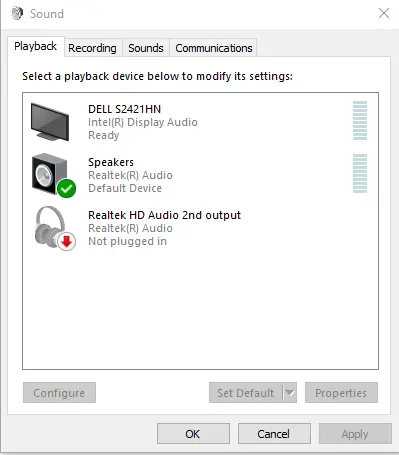This is a technical comparison between ASIO Vs WASAPI audio drivers. If you are confused about them, you should read this comparison till the end.
I remember, when I was just starting out my music production career, I encountered a term called “ASIO”, an exclusive audio driver used in professional music production applications.
However, Windows computers have their own driver called “DirectSound” for common applications such as playing media on Windows Media Player and other apps, ASIO is exclusively used in professional audio like audio recording and production.
BUT, today another term is getting popular called “WASAPI” which is a newer version of Windows audio driver, capable of playing along with ASIO.
Related,
Today, we will compare both ASIO and WASAPI audio drivers and know their use in audio playback and recording.
First off,
Table of Contents
What is ASIO?

ASIO or Audio Stream Input/Output is an audio device driver used in professional audio interfaces. These audio interfaces are generally used in music production, gaming, and other professional audio applications.
Disclosure: This post may contain affiliate links, which means we may receive a commission if you click a link and purchase something that we recommended. Read more about Affiliate disclosure here.
ASIO is a recommended audio device driver for professional audio recording programs (DAWs) and video editors.
The best thing about ASIO is, it’s a Low Latency Audio Protocol driver model that is perfectly suitable for music recording where accuracy is concerned.
ASIO was developed by Steinberg which is a leading company in music software and hardware solutions.
ASIO is designed to communicate directly with the audio hardware, bypassing the layers of the operating system which are the main reason for latency (delay) in audio processing.
As real-time, high-quality audio recording, and playback is required in music production, ASIO perfectly fits for this.
Every audio interface and sound card has its own ASIO driver specifically designed to work with ASIO-compatible software such as DAWs.
ASIO driver provides you low latency audio data transfer on multiple input and output channels and also provides you higher bit-depth and sample rates than Windows drivers.
These qualities of ASIO make it ideal for professional audio applications.
ASIO is quite effective in macOS and iOS EVEN these operating systems have their own low latency drivers called Core Audio and Audio Unit Extensions.
That’s why most audio interface manufacturers provide ASIO-compatible drivers and software also for macOS and iOS.
Over the last 20 years, ASIO is widely adopted in the music production industry because of its ability to provide low-latency and multiple input-output audio streaming and recording feature which is essential for tasks like recording, editing, and mixing audio.
What is WASAPI?

WASAPI or “Windows Audio Session API” is the relatively new audio driver introduced by Windows, released first in 2007 for Windows Vista.
It is a low-latency audio interface technology used in Windows computers that supports two modes shared and exclusive.
Apart from DirectSound API, WASAPI allows applications to directly control audio devices. It also provides a higher quality and low latency audio experience which was missing in DirectSound.
WASAPI Modes of operation:
- Shared Mode: Hsared mode allows multiple applications to share the same audio devices, such as speakers or headphones. In shared mode, WASAPI audio engine mixes the audio streams coming from different applications and sends them to the audio playback device, like audio interface, speakers, etc. This mode is suitable for multimedia playback like in the DirectSound drivers.
- Exclusive Mode: Along with the shared mode, WASAPI has another mode called Exclusive mode, in which the application takes exclusive control of an audio device, just like ASIO driver. This bypasses the audio signal directly to the audio hardware. This mode is useful for professional audio applications such as audio recording and playback where low latency is required to precisely record the audio.
WASAPI is a perfect audio driver to access change the settings of audio devices, control your professional audio sessions, manage audio sample rate and bit depth formats, etc.
However, it also supports low-latency audio input-output, in Profesional audio ASIO is widely used.
What is the Difference Between ASIO and WASAPI?
Well, ASIO (Audio Stream Input/Output) and WASAPI (Windows Audio Session API), both are high-quality audio drivers, there are some differences between them that make ASIO the first choice for professional audio.
Cross-platform support
ASIO was developed by Steinberg to operate in both Windows and macOS. Today almost all audio interfaces come with both Windows and macOS ASIO drivers.
On the other hand, WASAPI only supports Windows OS because is is exclusively designed by Windows, for Windows.
Latency
If we talk about Latency, ASIO beats WASAPI, however, Latency depends on the audio hardware, drivers, and system configuration.
If your audio interface has a high-quality DAC then you will get a low latency audio signal. But, ASIO is best in terms of low latency performance.
It’s highly suitable for professional audio applications where real-time audio processing is needed. ASIO drivers are actually optimized for low-latency operation. That’s why they beat WASAPI driver.
Direct hardware access
ASIO and WASAPI both support direct hardware access features which allow an application to bypass the operating system’s audio processing and send the audio signal directly to the audio device.
But, in WASAPI you have to choose the exclusive mode to enable this feature whereas in ASIO this feature is enabled and there is no option to disable this feature.
Sample Rate and Bit Depth Formats
Both the drivers support multiple sample rates and bit depth formats, however, ASIO has more options compared to WASAPI.
It all depends on your ASIO hardware, and how much sample rate it will support. Even some audio interfaces support sample rates upto 196kHz with 16 and 24 bits.
WASAPI has limited choice in sample rates like in most of the Windows computers 44kHz and 48kHz. Again it all depends on the hardware and how many bits of depth it will support. If the hardware is capable, you may see higher bit depths in WASAPI.
Compatibility with applications and software
ASIO is widely compatible with professional audio applications such as DAWs, and audio interfaces.
WASAPI is a Windows-based audio driver hence it only supports the in-built audio driver of the computer.
However, you will find audio interfaces in the market that support WASAPI, but actually, WASAPI is not built for professional audio applications. Well, it supports most Windows-based applications.
How Does ASIO Work and its Application?
Above I have already given some information about ASIO audio driver. It is developed by Steinberg primarily for professional audio applications and hardware.
ASIO provides high-performing, low-latency audio streaming which is required to record and listen to professional audio.
Let me show you the overview of how ASIO works and what are its applications.
ASIO allows audio applications to communicate directly with the audio hardware. It does not rely on the operating system’s audio processing.
The direct communication between the software and hardware allows you faster and more precise control over the audio. Direct access results in low latency and high performance.
Every ASIO-compatible hardware comes with an ASIO driver. When you install this driver on your computer, it acts as a bridge between the application and the audio hardware.
ASIO driver gives you an interface to send and receive audio data directly to and from the audio hardware.
ASIO bypasses all the operating systems bypassing the operating system’s audio stack which minimizes audio latency and gives you high performing audio signal.
ASIO also gives you the ability to configure the sample rate (number of audio samples per second) and buffer size which is required in audio recording. Along with these advantages, ASIO also provides multiple-channel input/output support.
ASIO is widely used in music production and it supports most of the Digital Audio Workstations (DAWs), such as, such as Ableton Live, Pro Tools, Cubase, Logic Pro, etc.
It allows the user real-time monitoring and low-latency playback during audio recording.
ASIO is also used in live performances where real-time audio monitoring and recording are required. Most of the audio interfaces today come with ASIO audio drivers to support all the major DAWs.
How Does WASAPI Work and its Application?
WASAPI or Windows Audio Session API is an audio driver introduced by Microsoft with Windows Vista in 2007. Later it was adopted in all the Windows operating systems.
WASAPI works on the concept of audio sessions. An audio session delivers a logical audio stream associated with the application.
According to WASAPI Windows guide, any application may have single or multiple audio sessions. WASAPI allows you to control each session separately.
WASAPI has two modes, shared and exclusive modes.
Shared mode shares the audio session with multiple applications and you will get the combined audio from the applications to the speakers.
Exclusive mode bypasses the audio engine and only the opened application uses the WASAPI driver. This mode provides lower latency and higher performance compared to shared mode.
The exclusive mode gives the application direct access to the audio hardware. This mode is useful for professional audio applications which require low latency.
WASAPI driver is used in Multimedia Playback (media players and browsers), Gaming, Music Production, and communication Applications (voice chat, video conferencing etc).
What is DirectSound?
DirectSound is also an audio API (Application Programming Interface) provided by Microsoft. It is part of DirectX technology.
DirectSound was introduced with DirectX 1.0 and it has been upgraded with each new version of the DirectX.
It is one of the primary sound drivers of Windows computers for multimedia and gaming applications.
DirectSound provides audio playback and recording, 3D sound, mixing, and effects along with hardware abstraction.
But it has high latency so you cannot use it in professional audio recording. That’s why Windows introduced WASAPI to bypass all Windows works and direct access to the audio hardware by the application.
ASIO Vs WASAPI Vs DirectSound
Now let’s side by side compare ASIO, WASAPI, and DirectSound.
| ASIO | WASAPI | DirectSound |
|---|---|---|
| Developed by Steinberg | Developed by Microsoft | Developed by Microsoft |
| Low-latency | Low-latency | High-latency |
| Direct hardware acces | Direct hardware access | Shared mode |
| Multichannel support | No multichannel support | No multichannel support |
| Sample rate and bit depth flexibility | Sample rate and bit depth flexibility | – |
| Application focus | Application focus | Multimedia focus |
| Adopted by professional audio hardware manufacturers | Exclusive to Windows | Exclusive to Windows |
FAQs For ASIO Vs WASAPI
Which is better ASIO, WASAPI, and DirectSound?
It depends on your work. If you prefer professional audio recording then ASIO is better. For general multimedia, WASAPi and DirectSound are better.
Is WASAPI better than ASIO?
No, ASIO is better than WASAPI in terms of lower latency and performance. However, for general multimedia, WASAPI is better than ASIO.
Does ASIO or WASAPI really optimize sound quality?
Compared to DirecrtSound, WASAPI and ASIO both provide better sound quality.
Is there a problem if I use WASAPI instead of ASIO?
ASIO is specially built for professional audio applications. Such as audio recording. So, if you want to record flawless audio, you should use ASIO-compatible hardware instead of WASAPI.
Related,



![What is Microphone Gain [Complete Guide About Microphone Gain]](https://www.recordingbase.com/wp-content/uploads/2022/01/microphone-gain.png)
![How to Connect XLR Mic To Computer [3 Methods]](https://www.recordingbase.com/wp-content/uploads/2021/12/3-ways-to-connect-xlr-mic-to-computer.png)

